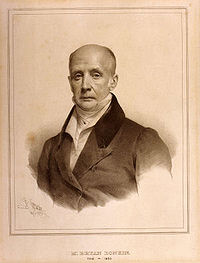Bryan Donkin
| Bryan Donkin | |
|---|---|

Bryan Donkin
|
|
| Born | 22 March 1768 |
| Died |
27 February 1855 (aged 86) Bermondsey, London |
| Cause of death | Natural decay from extreme age |
| Resting place | Nunhead Cemetery |
| Residence | 6 The Paragon, Bermondsey, London |
| Nationality | English |
| Known for | Paper making machine and canning process |
| Spouse(s) | Mary Brames |
| Children | 11 |
Bryan Donkin FRS (22 March 1768 – 27 February 1855) was an English engineer and industrialist. Of his six sons, John, Bryan, and Thomas also became engineers.
Raised in Sandhoe, Northumberland., his father was a surveyor and land agent. Donkin initially began work in the same business, and worked from September 1789 to February 1791 as bailiff at Knole House and estate for the Duke of Dorset.
While working for the Duke of Dorset, Donkin consulted the engineer John Smeaton, an acquaintance of his father, as to how he could become an engineer. At Smeaton's advice in 1792 he apprenticed himself to John Hall in Dartford, Kent, who had founded the Dartford Iron Works in 1785. Shortly after completing his apprenticeship, he set himself up in Dartford, with the support of John Hall, making moulds for paper works, for at that time all paper making was done by hand. In 1798 he married Mary Brames, daughter of Peter Brames, a neighbouring land owner and market gardener, and a prominent supporter of the Methodist movement. By doing so Donkin became brother in law to John Hall, who had married Mary's elder sister Sarah in 1791.
In 1801-2 Donkin was entrusted with the construction of a prototype of a paper-making machine, the famous Fourdrinier machine, the perfection of which had caused some considerable problems. Donkin took premises at Bermondsey, London in 1802, thus starting the enterprise that became the Bryan Donkin Company, which still continues in business in the early 21st century. In 1804 he succeeded in producing a working machine. A second, improved one, was made the following year and in 1810 eighteen of the complex machines had been erected at various mills. Although the original design was not Donkin's, he received the credit for having perfected them and brought them into use. His company continued to make such machines, and by 1851 had produced nearly 200 machines for use across the world.
Donkin also worked with printing machinery. In 1813 he and a printer, Richard Mackenzie Bacon of Norwich, obtained a patent for a "Polygonal printing machine"; this used types placed on a rotating square or hexagonal roller or "geometric prism". Ink was applied by a roller which rose and fell with the irregularities of the prism. One of these machines was set up for Cambridge University. It however proved too complicated and suffered from poor inking, which prevented its success. However, it was the first machine to introduce composition ink rollers which were considered better than the existing leather-covered rollers. Donkin's inking roller quickly became the industry standard.
...
Wikipedia
